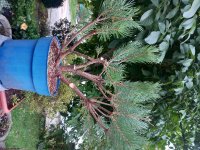Jesters1gamble
Seedling
Hello all I picked this silver pine pinus sylvestris watereri up in September this year and chopped the center trunk and other branches. I was going to try air layer 2 of the branches but I'm thinking now of a multi trunk windswept. I have not messed with the roots yet so i don't know what the nebari looks like. Let me here your thoughts please

